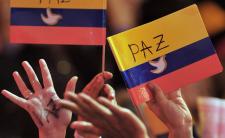Colombia is located in Northern South America. It borders the Caribbean Sea and the North Pacific Ocean, and Panama, Venezuela, and Ecuador. Its total area is slightly less than twice the size of the US state of Texas. Its natural resources include petroleum, natural gas, coal, iron ore, nickel, gold, copper, emeralds and hydropower.
According to 2008 estimates, Colombia has a population of 45,013,672, with a median age of 26.8 years and a growth rate of 1.405%. Life expectancy at birth is 72.54 years. The major ethnic groups are 58% mestizo, 20% white, 14% mulatto, 14% black, 3% mixed black-Amerindian, and 1% Amerindian. Ninety percent of the population is Roman Catholic, and 92.7% of the population is literate (can read and write at 15 years of age or older). The GDP per capita for 2008 was US$9,000.
Constitutional History
1886 Constitution
Colombia has had several constitutions. The first constitution which was in force for a significant period was promulgated in 1886 after an agitated constitutional period in the 19th century. It remained in force until 1991. The 1886 Constitution established a strong state with three branches of government, with the executive being the dominant branch. The executive had control over 160 state enterprises, including the banking sector (putting public and private credit under its control), electricity, and petroleum.
Between 1886 and 1991, there were several Constitutional amendments. Most notable was the 1957 amendment, which formally established bipartisanship after a long period of violence known as La Violencia, caused by disagreements between the liberals and the conservatives, who were the main political parties. The so-called Frente Nacional (National Front), a system of government which called for equal numbers of liberal and conservative delegates in the Congress, and for alternation between liberal and conservative Presidents. The Frente Nacional remained in effect until 1986, when the election of a liberal president coincided with the unilateral decision of the conservatives to terminate the system. Although the Frente Nacional formally ended La Violencia, the rigid bipartisanship it established led to further political violence since it in effect disenfranchised anyone who was not a liberal or a conservative. This disenfranchisement led to the reforms which resulted in the 1991 Constitution.
1991 Constitution
In 1991, a reform movement led to the drafting of another constitution. The process began with an attempted reform in 1988 intended to involve the population in the political process and to counter corruption amidst an ongoing civil conflict. The failed1988 reforms instigated a student movement named Todavia podemos salvar Colombia (we can still save Colombia). The students and youths demonstrated on the streets demanding a constitutional assembly to address the ongoing conflict. The movement proposed a constituent assembly for the 1990 elections and held a special ballot called the septima papeleta (Seventh Ballot) during the regular elections. Although the Electoral Counsel did not officially count the Seventh Ballot votes alongside the votes for Senate, Chamber of Representatives, Department Assemblies, Governors, Municipal Councils and Mayors, the Seventh Ballots were unofficially tallied. There was a near unanimous positive response to the Seventh Ballot. The Supreme Court validated the Seventh Ballot, and elections for the representatives of the National Constituent Assemblies were held.
The Constitutional Assembly was inclusive and representative. Seventy delegates were chosen after a nation-wide election, and included members from every strata of society, including professional politicians, ex-guerillas, Indian leaders, businessmen, social leaders, labor leaders, peasants, clerics and academics.
The demand for a new constitution was driven by the need to establish modern democratic institutions that would encourage greater participation in the democratic process, strengthen the rule of law in order to defuse political violence, and to secure human rights by establishing mechanisms for the protection of these rights.
The 1991 Constitution is also known as the “Human Rights Constitution” because it recognizes not only the classic fundamental negative rights dating back to the French Revolution but also economic and social rights. The 1991 Constitution created three mechanisms to protect these rights: (a) tutelage, which allows a party to bring an action to suspend any action or omission of a governmental or private entity that threatens a fundamental right; (b) the Defensor del Pueblo, a Human Rights Ombudsman elected for a four year term by the House of Representatives, who monitors the protection and development of human rights; and (c) class actions designed to protect collective interests and rights.
The 1991 Constitution was amended by reforms in 1993, 1995, 1996, 1997, 1999, 2000, 2001, 2002, 2003, 2004 and 2005.
Timeline for Constitution Building Process
| 1810 | Colombia declares independence from Spanish Crown. First constitution promulgated. |
| 1819 | Republic of Gran Colombia declared (includes Venezuela, Ecuador, and Panama). |
| 1830 | Ecuador and Venezuela secede from Gran Colombia. |
| 1863 | Establishment of the United States of Colombia. |
| 1886 | The Constitution of 1886 establishes the Republic of Colombia, following a period of instability characterised by many constitutions. |
| 1903 | Panama secedes from the Republic of Grand Colombia. |
| 1947 | Start of civil war between the liberal and conservative parties. |
| 1957 | Constitutional amendment paves the way for reconciliation between the liberals and conservatives, establishing a mechanism for politcal power sharing known as the Frente Nacional. |
| 1968 | Constitutional reform strengthening the President by allowing his office to control the national budget, revenues, and expenditures. |
| 1986 | End of the Frente Nacional when the election of liberal president Virgilio Barco coincided with the unilateral decision of the conservatives to terminate the pact. |
| Early 1990 | Seventh Ballot elections gets an almost unanimous vote. |
| December 1990 | Elections for seventy delegates for the Constitutional Assembly held nationwide. |
| July 4, 1991 | 1991 Constitution adopted. |
| Branch | Hierarchy | Powers | Removal |
|---|





Share this article